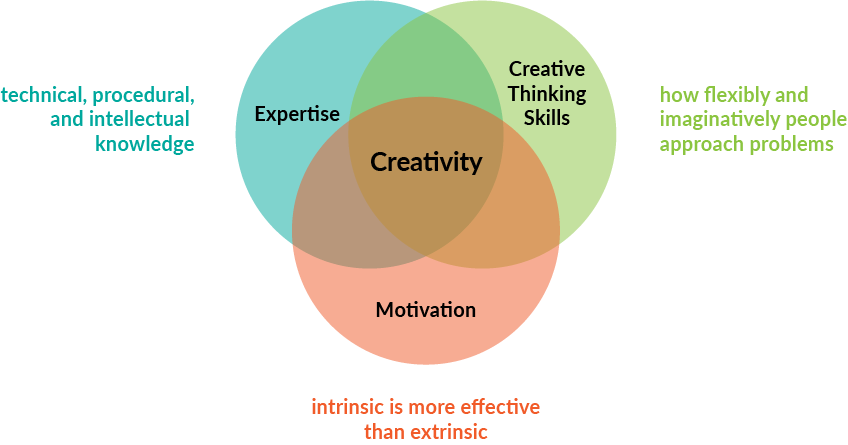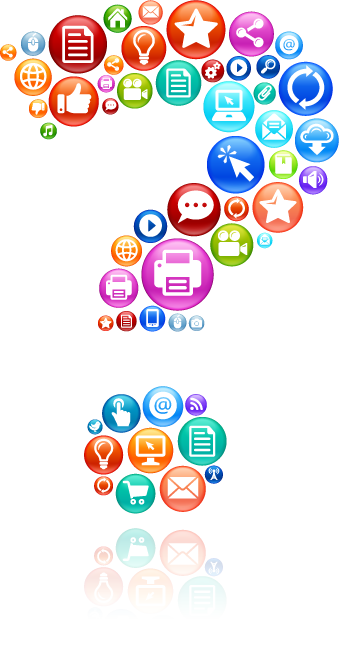
Click to start
Introduction
Creativity and Leadership
What is Creativity?
There have been many definitions about creativity. Please use the slider to discover them.
Components of Creativity

Adapted from Adams, K. "Sources of innovation and creativity: A summary of the research"
Your Turn #1
Creativity Techniques
Brainstorming Technique

Brainstorming is one of the most widely used and extremely effective methods for divergent idea generation.
This technique was developed by New York advertising executive Alex Osborn around the years 1939-1941. In 1953 the procedures and rules had been defined and appeared in his book Applied Imagination. The development of this original technique was revolutionary and has since changed our world.
With increasing refinement of the process, and the introduction of creative thinking techniques, the world of easy idea generation is yours for the taking. You need never be stuck for a new idea, whether you are in a group or working by yourself.
Brainstorming Rules
Brainstorming is a problem-solving conference method that is based upon the stimulation of one person’s mind by another.
An average brainstorming session consists of a group of 4 to 6 people sitting around table and spontaneously producing ideas designed to solve a specific problem. Prior to opening the session, the group leader will set the stage by reviewing the following group brainstorming rules:
Brainstorming Advantages vs Disadvantages
-
Advantages
- The rules of brainstorming is easy to understand, easy to master and use.
- It is inexpensive, simple technique, that requires few material resources.
- Many ideas can be generated in a short time.
- Encourages creative thinking and thinking "out of the box"
- One idea can spark off other ideas.
- Is a democratic, fun and exiting way of generating ideas.
- Provides an opportunity for widespread participation and involvement.
- Everyone can be involved equally, every idea is a worthy one.
- Spirit of cooperation is created.
- Develops a creative abilities and creative thinking of group members.
- Universality of the method and possibility to combine it with other technique.
-
Disadvantages
- Requires an experienced and sensitive facilitator.
- Can be chaotic, unfocused and intimidating.
- Can take too much time if the group is not properly controlled.
- If not managed well, criticism and negative evaluation may occur.
- More discrete participants might find it difficult to express their crazy ideas.
- Lack of reliable criteria that determine the quality of solutions.
Your Turn #2
Mind Mapping Technique
Mind mapping, developed by Tony Buzan, also has been called "spider diagrams" represents ideas, notes, information, etc. in far-reaching tree-diagrams. To draw a mind-map:
- Layout a large sheet of paper in landscape and write a concise heading for the overall theme in the center of the page.
- For each major sub-topic or cluster of material, start a new major branch from the central theme, and label it.
- Each sub-topic or sub-cluster forms a subordinate branch to the appropriate main branch.
- Carry on in this way for ever finer sub-branches.
How to Create Mind Mapping
There is a guideline from Buzan for creating mind maps:
- Start in the center with an image of the topic, using at least 3 colors.
- Use images, symbols, codes, and dimensions throughout your mind map.
- Select key words and print using upper or lower case letters.
- Each word/image is best alone and sitting on its own line.
- The lines should be connected, starting from the central image. The lines become thinner as they radiate out from the center.
- Make the lines the same length as the word/image they support.
- Use multiple colors throughout the mind map, for visual stimulation and also for encoding or grouping.
- Develop your own personal style of mind mapping.
- Use emphasis and show associations in your mind map.
Your Turn #3
The Reframing Matrix
A Reframing Matrix is a simple technique that helps you to look at organizational problems from a number of different viewpoints, and expands the range of creative solutions that you can generate.
The basic approach relies on the fact that different people with different experiences approach problems in different ways.
This technique helps groups to put themselves into the mindsets of different people and imagine the solutions, or problems, they would come up with regards to a key question or problem.

Advantages of Reframing Matrix
- Reframing is seeing the current situation from a different perspective, which can be helpful in problem solving, decision making and learning.
- Reframing is helpful in situations where a person feels stuck or confused.
- The aim of reframing is to shift one’s perspective to be more empowered to act – and hopefully to learn at the same time.
- Many times, merely reframing one’s perspective on a situation can also help people change how they feel about the situation, as well.
- Many fields regularly use reframing, including therapy, coaching and even marketing and sales.
Your Turn #4
The Gordon Technique
The Gordon Technique is closely related to brainstorming, in that it is a group conference method in which an unevaluated free-flowing discussion is encouraged.
But in its pure form, there is one basic difference. No one, except the group leader, knows the exact nature of the problem under consideration.
This technique aims to avoid what has been termed "egocentric involvement". Gordon feels that there is danger in an ordinary brainstorming session of a participant becoming convinced that one of the ideas he has proposed is the best possible solution to the problem.

Your Turn #5
The Check-Listing Technique
A checklist is an accumulation of points, areas of possibilities serving to provide ideas-clues or ideas, when checked (or compared) against the problems or subjects
under consideration.
The objective is to obtain a number of ideas for further follow-up and development. It is one of the most commonly used aids in the search for new ideas. The checklist technique can be helpful and dangerous. It can be dangerous, unless open-ended. Each phase is infinitely open-ended.
Checklists are aimed at solving some specific problem. They help our faulty memory. They make sure we have checked those steps, which have been successfully used to solve certain types of problems in the past.

The Synectics Technique
This is a technique that forces one to talk about the problem in another manner, to use other descriptive words in another form, mainly, by using analogies as the mechanisms for making the familiar strange and strange familiar.
Synectics research has three main assumptions:
- The creative process can be described and taught
- Invention processes in arts and sciences are analogous and are driven by the same “psychic” processes
- Individual and group creativity are analogous

Your Turn #6
The Morphological Analysis Technique
Morphological analysis is a structured, comprehensive way to list & examine many possible combinations that might be useful in solving a problem.
The steps of morphologic analysis are:
- First: defined the problem term of its parameters.
- Second: develop a model to make it possible to visualize every possible solution. If the problem has only two parameters, or variables, the model takes the form of a large rectangle divided into a series of small squares. The horizontal axis represents one variable, & is subdivided into the different forms of this variable.

The Attribute Listing Technique
By means of this technique, it is possible for a leader to bring together new combinations of characteristics or attributes that will better fulfill some existing need.
There are two steps in the attribute listing technique:
- The first is to list all of the various characteristics of the study object.
- The second is to deliberately change or modify these characteristics.
This is a forcing technique for developing unique verbal solutions by forming measurable comparisons between the elements of dimensions, physical properties, mechanical properties, electrical and magnetic properties, cost considerations and other properties.

The Phillips 66 Technique
This technique is found by J. Donald Phillips, in order to attempt to overcome some of the reasons that people are reluctant to express themselves in group situations.
It is a group discussion technique to help people overcome the problem of silence in any group situations and to ensure that everyone gets a chance to contribute to the discussion.
The leader divides the group into sub-groups of six participants each. These groups each spend six minutes discussing possible solutions to an identified problem, and then report back to the larger group with a proposed solution.

Your Turn #7
Goal-Orientation
It has been suggested the use of goal orientation in the selection process.
Here’s how a leader can use goal-oriented creativity:
- Select and set the goals. As applicable, do pooling for goals before selecting them.
- Do some evaluations and planning. With the planning process, proceed from the goals to the starting point in order to gain an understanding of what are the main milestones and resource needs of your project, and what you want to achieve with each milestone.
- For each milestone investigate not only what is required for achieving the milestone, but also what is required for successful implementation of that particular milestone. That is, getting to the goals is only part of the story. Having an understanding of what is required for functioning successfully in each milestone is as important.
- Continue this way until your starting point. Do research as necessary.

Your Turn #8
The Crawford Slip-Writing Technique
This method is a simple yet effective type of brainstorming that gives the opinions of all team members equal weight, however quiet they are.
Not only does this help a leader generate a wide variety of solutions, it also helps people get involved and feel that their contributions are valued. So, it is a form of individual brainstorming.
The advantage of this technique is that it provides many ideas for a wide range of different problems in one session in a short period of time. Each person in a large audience is given a colored slip of paper (nowadays often on sticky notes) upon which he is asked to write down his ideas relating to the stated problem. The slips are collected to be evaluated later.
